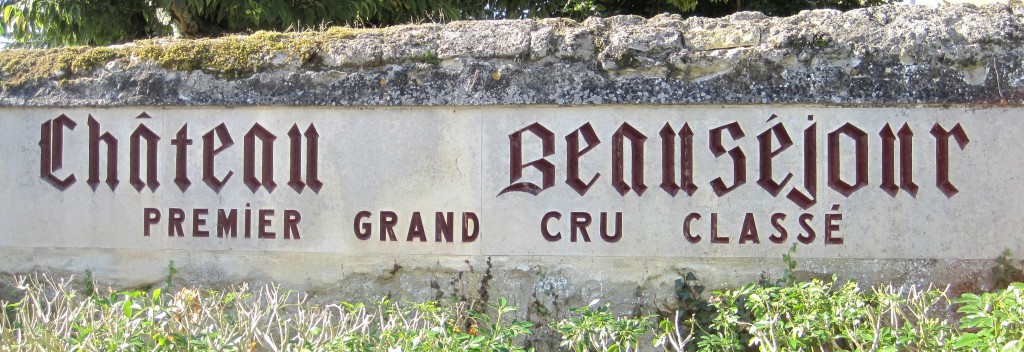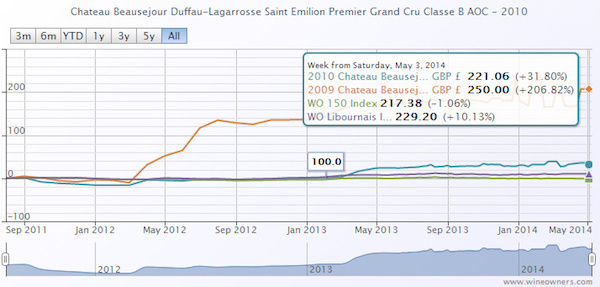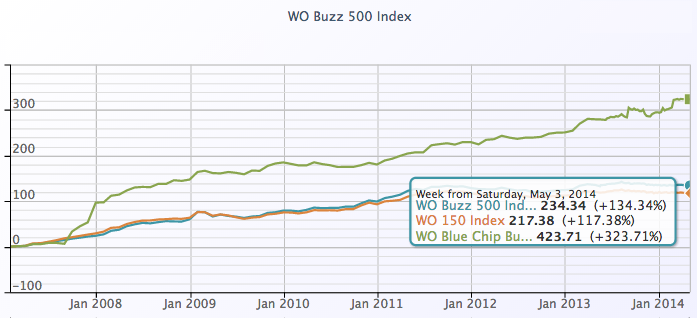by Wine Owners
Posted on 2014-08-18

by Wine Owners
Posted on 2014-05-09

Beausejour Duffau is a great success story of recent years, especially if you are one of the buyers lucky enough to have secured an allocation of the 2009 (in particular) and 2010, both of which received price-boosting perfect ratings from Wine Advocate. The 2009, for example, which has been trading at £2850 has shown nothing but upside since release. The opening EP price here was £800, which is enough to deter the casual buyer, but those who fell in love with the wine from barrel samples have had their faith well rewarded by a market price of £3000, an increase of 270%, which is truly remarkable in an otherwise relatively stale market, and vastly outstrips the performance of pretty much anything else.
Buyers of the 2010 show an increase of around 30%, still very much bucking the trend, but slightly less favoured than the 2009, with an equivalent market price of £2652. Given the release price of the 2010, close to £2000 per case, buyers in that vintage were in a sense late to the party, the chateau having had the confidence to price quite aggressively in its second consecutive great vintage. The pricing performance here is probably also coloured by the fact that the 2009 was given a range of 96-98+ in initial tastings by Parker, while the 2010 was offered a marginally more confident 96-100, both being respectively upgraded and confirmed in a 100 point score.
Lucky owners of the 2009 are left in the enviable if awkward position of having to decide whether to take their £2000 per case profit now, or hold in anticipation of future increases (the last perfect score for Beausejour Duffau was 1990 which now trades at £7,500+ per case and has consistently risen since 2006).
There is always the option of laying it down for future drinking in the knowledge that it’s a 100 point wine for which they paid well below the odds on release. Given 2009 is in all likelihood a decade away from entering its maturity plateau, how many savvy buyers will be prepared to drink a case of wine that might be valued at £7,500-£10,000 by then?

by Wine Owners
Posted on 2014-05-08
The Buzz 500 was always meant to be a bit of fun. Away from the serious business of formulating the fine wine equivalent of the FTSE100, and key region of production tracker indices, we thought it would be interesting to create a ‘popular’ index.
So we took the 100 most searched for wine names on Wine-Searcher, selected 5 vintages per wine that differed according to region, and turned that list into an index. Well, why not?
We wanted answers to the question: are those wines that are most searched for on Wine-Searcher also those that perform the best over the medium term? Will the most searched-for wines tend to be the most demanded? Does most researched translate into purchases, and does that lend support to, or underpin market pricing?
We kicked off the Buzz 500 at the start of 2013, and from that point onwards, it’s outperformed the WO150. That’s not entirely surprising given the strong Bordeaux representation in the latter index. But actually the Buzz 500 has plenty of claret represented too, just different wines. This highlights the first conclusion: there are always outperformers in any segment, and there is a correlation between the most searched for wines in a category and their performance versus other birds of a feather.
You can Review the constituents of each of the indexes here.
But just because hot wines within a category will outperform other wines in the same category, there’s no substitute for market momentum: and nowhere has that been greater than in burgundy these past three years.
So comparing the Buzz 500 to the Blue–chip Burgundy index is – well, rather predictable.
Whilst Burgundy has risen 40% in the last 3 years, the Buzz 500 has managed a paltry 5.5%. That’s still a third better than the poor WO150, weighed down by its First Growth constituents.
If you're a Burgundy officianado that may be good news, or conversely may have put whole classifications of wine out of your drinking reach. And whilst the scarcity of Burgundy is a huge market driver that may point to inexorable upwards momentum, who’s to say it will continue?
The wine market is characterised by myopia – unable or unwilling to see an end to positive trends, and morose in the extreme when sentiment turns . Neither are helpful for collectors.
One behaviour that is consistently predictable is that when wine markets become disconnected with the value in those purses that consume it, the trade and consumers search for better value, Hence the positive kick enjoyed by Northern Italy. More about that in my next index analysis.


